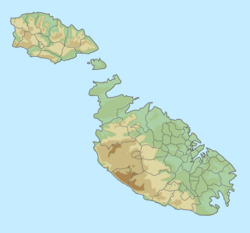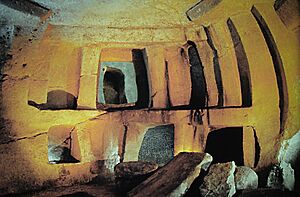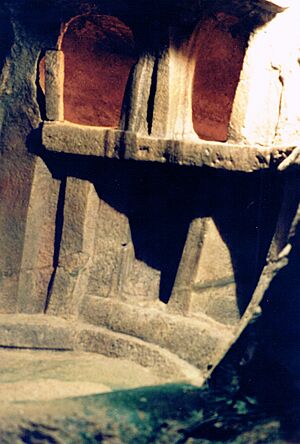Ħal Saflieni Hypogeum facts for kids

The Hypogeum, photograph by Richard Ellis, before 1910
|
|
| Alternative name | Ħal Saflieni Prehistoric Hypogeum (official name) |
|---|---|
| Location | Paola, Malta |
| Coordinates | 35°52′10.5″N 14°30′24.5″E / 35.869583°N 14.506806°E |
| Area | 500m2 |
| History | |
| Material | Limestone |
| Founded | c.4000 BC (earliest remains) |
| Abandoned | c.2500 BC |
| Periods | Saflieni phase |
| Site notes | |
| Excavation dates | 1903–1908, 1990–1993 |
| Archaeologists | Manuel Magri Themistocles Zammit |
| Condition | Preserved and restored in 2017 |
| Ownership | Government of Malta |
| Management | Heritage Malta |
| Public access | Yes (limited) |
| Official name | Ħal Saflieni Hypogeum |
| Type | Cultural |
| Criteria | iii |
| Designated | 1980 (4th session) |
| Reference no. | 130 |
| Region | Europe and North America |
The Hypogeum of Ħal Saflieni (Maltese: Ipoġew ta' Ħal Saflieni) is an amazing underground structure in Paola, Malta. It was built a very long time ago, during the Stone Age, between 3300 and 3000 BC. The word "Hypogeum" means "underground" in Greek.
People think the Hypogeum was a special place for worship and a burial ground. Archaeologists have found the remains of more than 7,000 people here! It is one of the best examples of Malta's ancient temple-building culture. This culture also created the famous Megalithic Temples and the Xagħra Stone Circle.
Contents
What Does "Ħal Saflieni" Mean?
The Hypogeum is named after the old village that used to be above it, called Ħal Saflieni. The word Ħal means "village," and saflieni means "low." Both words come from Arabic languages. This means the name "Ħal Saflieni" was given after Muslims arrived in Malta.
How Was the Hypogeum Discovered?
The Hypogeum was found by accident in 1902. Workers were digging to build water tanks for new houses when they broke through its roof. At first, the workers tried to keep it a secret. But soon, the amazing underground temple was discovered.
The first person to study the Hypogeum was Manuel Magri. He started digging in November 1903. Sadly, during his work, some items like grave goods and human remains were removed and lost. Magri died in 1907, and his report about the Hypogeum was never found.
Later, Sir Themistocles Zammit took over the excavations. He tried to save what he could. Zammit published reports starting in 1910 and continued digging until 1911. He placed his findings in the National Museum of Archaeology in Valletta. The Hypogeum was first opened to visitors in 1908, even while digging was still happening.
The houses built above the Hypogeum were later taken down to create a museum. More digging happened between 1990 and 1993. The Hypogeum was then closed for nine years, from 1991 to 2000, for important restoration work.
Since it reopened, Heritage Malta, the group that looks after historical sites, only allows 80 people to visit each day. This helps protect the delicate environment inside. In 2011, a special program began to watch over the site and prevent it from decaying. Scientists are still studying the Hypogeum. In 2014, a team of scientists visited to study its unique sounds. The Hypogeum closed for another year in 2016 for more improvements. It reopened in May 2017 with a better system to control the air inside.
Exploring the Hypogeum
Archaeologists believe there was once a small building or shrine on the surface that marked the entrance to the Hypogeum. When this building was destroyed, it likely kept the underground structure hidden for thousands of years.
The Hypogeum might have started as a natural cave. Over time, people expanded it by cutting into the soft rock. They used simple tools like antlers, flint, and obsidian. The oldest burial chambers are on the upper level. The lower chambers were added later. The site was probably used from about 4000 BC until 2500 BC.
The builders of the Hypogeum were very clever. They designed the structure so that light from the surface could reach the lower chambers. They also painted beautiful patterns on some ceilings using red ochre. These patterns include spots, spirals, and honeycomb shapes. One important room, called "The Holy of Holies," seems to be lined up with the winter solstice. This means sunlight would have shone on its front from the original opening above.
There's a special spot in the middle chamber, called the Oracle Room. It has a niche (a small carved-out space) that makes sounds echo. This might have been used to make chanting or drumming sounds fill the entire Hypogeum.

Many interesting objects were found at the site. These include decorated pottery, stone and clay beads, shell buttons, amulets, axe-heads, and carved figures of humans and animals. The most famous discovery is the Sleeping Lady. This is a clay figure that might represent a mother goddess.
The figures found range from simple to very detailed. Many of them seem to be about honoring the dead or spiritual changes. Some pottery shows amazing art. One large bowl has realistic pictures of cows, pigs, and goats on one side. The other side has hidden animals within complex geometric patterns.
It is thought that the remains of 7,000 people were found in the Hypogeum. Many bones were lost early on, but most of the skulls are kept at the National Museum. A few of these skulls have an unusual elongated shape. This has led to many ideas about the people who used the Hypogeum and their beliefs.
Structure of the Hypogeum
The Hypogeum is built entirely underground. It has three levels carved into soft limestone. Its halls and chambers are connected by a maze of steps, doorways, and stone beams. People believe the upper level was used first. The middle and lower levels were dug out later. Some rooms on the middle level look similar to the Megalithic Temples found elsewhere in Malta.
Upper Level
The first level is only about one meter below the ground. It is different from other tombs found in Malta. Some rooms on this level were natural caves that were later made larger. This level has many rooms, and some were used for burials.
Middle Level
The second level was added later. Large rocks were lifted to the surface using special equipment. This level has several important rooms:
- Main Chamber: This room is mostly round and carved from rock. It has several carved doorways, some leading to other rooms, and some just carved into the wall. Most of the walls here are painted with red ochre. The famous Sleeping Lady figure was found in this room.
- Oracle Room: This room is rectangular and one of the smaller side chambers. It has a special feature: any sound made inside it creates a strong echo throughout the Hypogeum. The ceiling of this room is beautifully painted with red ochre spirals, circular spots, and more spirals.
- Decorated Room: Near the Oracle Room is another large, round hall. Its smooth walls slant inward and are richly decorated with geometric spiral patterns. On one wall, there is a carving of a human hand in the rock.
- Holy of Holies: This might be the most important room in the Hypogeum. It seems to be aligned with the winter solstice, so sunlight would have lit up its front from the original opening above. No bones were found in this room during the excavations. The main feature is a porthole (a round opening) within a trilithon. A trilithon is a structure made of two large upright stones with a third stone placed across the top. This trilithon is framed by an even larger one, and then another! The curved ceiling suggests that Malta's surface temples might have had similar roofs.
Lower Level
The lowest level of the Hypogeum contained no bones or offerings.
Visiting the Museum
The Hypogeum and its museum are very popular in Malta. The museum opens at 9 AM, but people often start lining up for tickets around 8 AM. A small number of "last minute" tickets for the next day are available from the National War Museum in Valletta. It is best to book your tickets months in advance because only a limited number of people can visit each day.
The site closed in September 2016 for a big renovation project that cost €1.1 million. Part of the money came from grants from Iceland, Norway, and Liechtenstein. The renovated museum was officially opened on April 28, 2017. It now has a new system to control the climate inside the Hypogeum and a larger visitor center. The site reopened to visitors on May 15, 2017.
See also
- Xagħra Stone Circle
- Ġgantija
- Petrosomatoglyph
- World Heritage Sites
- List of World Heritage Sites in Western Europe






